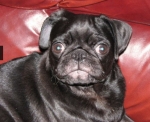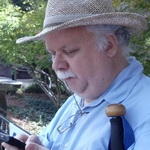First, let me offer my apologies for my delay in responding to this. Pugsy pointed it out to me ... but I've had a pretty busy period at home. We recently adopted a new rescue dog. He's about one year old and keeping us busy - with training and adjusting to one another.
The good news is that it appears he will work out and become a service dog for me .. at least at home .. and possibly everywhere. He's VERY friendly and meets people well. Plus he seems to be driven to try to please.
That's a blessing because it's possible I will need it sooner than I would like. I appear to be developing vocal cord paralysis. All it takes is a busy day and suddenly my vocal cords seem to lack all normal vibration (it feels as if someone gave me something to numb my vocal cords). My speech just has the sibilants, no tone. Sigh! If it's not one thing it's another.
Add to that, I seem to get "weak" .. feel as if I must REALLY concentrate .. if I have a busy day. It's almost as if I've had too much to drink, needing to do that concentration to get things done .. but without the fuzzy headed feeling. Yuck!
So, my apologies on my delay. I've had more fun that I would like.
Now, let's tackle your post.
First, Tom W, as you might know, Pugsy and -SWS are two of the best members of the forum. They are offering good information for you. I'm glad to see you were in very capable hands.
Next, let's tackle the BiPAP versus CPAP versus ASV treatment. As you've noted, as your pressure increases the central apneas tend to increase. You are reacting to the pressure in a negative manner. This type of apnea is known as Complex Sleep Apnea Syndrome (ComplexSA). Until recently it was not well understood or accepted by most doctors. Most now accept that it exists (based on plenty of studies). And most also recognize the gold standard for treating ComplexSA is the use of an ASV unit to provide therapeutic Positive Airway Pressure. It beats out older techniques, such as the Spontaneous/Timed BiPAP unit (BiPAP S/T) and the addition of supplemental oxygen to the xPAP therapy.
You note:
Tom W wrote:... I go back in 2 weeks and even if he prescribes an ASV machine to reduce/eliminate the Centrals I’ll still wind up with an AHI close to or just over 10. Is this the best I can expect? ...
The fact that you then go on to note that your glottis seems to close at the higher pressure may well interfere with your xPAP therapy (regardless of the type). However, it may not be all that bad. It's possible that is mostly positional (on your back).
So, you might want to explore if there is a position where that is not as much of a problem.
You should also question the use of just BiPAP to address the central sleep apnea.
Do NOT settle for "this is the best I can expect"!!!! Untreated central sleep apnea is just as deadly (literally) as obstructive sleep apnea. I had a hard time getting my doctors to listen to it. It took me breaking down in tears before I could get a doctor to listen that I had HORRIBLE problems with sleep onset central sleep apnea. (I would stop breathing so long - over a minute - that my BiPAP unit would think I was no longer attached and turn itself off !!! But because it was sleep onset, it was not "scored" ... At more than a minute, WHO GIVES A TINKERS DAMN when it occurs !!!.) Unfortunately, by that time the uncontrolled high blood pressure had damaged my kidneys. I now have to be fairly careful about my diet and medications. Gee THANKS!
So, I repeat. Do NOT settle for "this is the best I can expect"!!!! Untreated central sleep apnea is deadly.
Now, I don't want you to panic about this. There are always tweaks that can be made to the therapy that will make it work. For example, as if the glottis closing is positional (you might have noted that as well). So, you might need to pin the tennis balls to the back of a T-Shirt to help stay off your back.
Also, if you find the BiPAP does NOT address the central apneas, be CERTAIN to INSIST on a trial of ASV. This will require an ASV titration study. Essentially, they will titrate to eliminate the obstructive sleep apnea and make certain the high pressure is not too much for you.
You might be wondering if the high pressure is bad with Complex Sleep Apnea. In fact, it is not. Because the unit is NOT attempting to clear an obstruction. Instead it is helping to continue your respiration even when you fail to breathe. You see, Central sleep apnea (which is a part of Complex Sleep Apnea) results from an overshoot / undershoot cycle. That is for whatever reason (in your case the Positive Airway Pressure itself) you stop breathing as you should. This is the initial UNDERSHOOT side of the cycle. When that happens, the CO2 builds up in the blood stream until your body finally kicks in and restarts respiration. However, since the CO2 has built up abnormally high you start to slightly hyperventilate and blow off too much CO2. This is the OVERSHOOT side of the cycle. And unfortunately, it sets the stage for another UNDERSHOOT side, since you often will blow off too much CO2. This also leads to your periodic breathing (which your sleep studies and equipment have observed).
To break this repetitive cycle, the ASV quickly increases the pressure until it helps ascertain respiration even when you are not breathing as you should. This respiration allows your body to blow off enough CO2 so that you do not kick into the OVERSHOOT side of the cycle. Because the unit adapts to your breathing style and includes the timed response, it is known as Adaptive Servo Ventilation (ASV). For what it's worth, I note in my ICE app on my phone and in my MedicAlert emergency health record that I use a ventilator at night. You can not assume that I will breathe as I should when I am not conscious.
Yes, it can take a bit of tweaking to get ASV to work well with ComplexSA, but it does work. You are definitely not alone here. So, don't loose hope.
Anyway, I hope that helps.


















